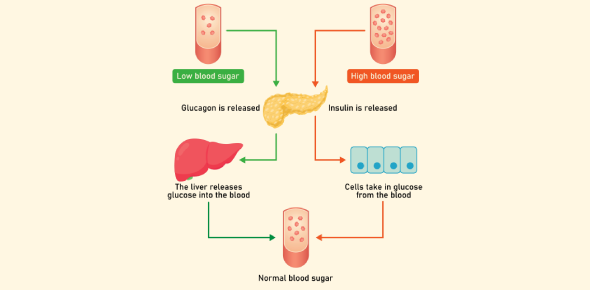What cells in the pancreas release insulin?
Which of the labeled subunits are involved in binding the receptor to...
Receptor tyrosine kinase phosphorylates other proteins, for example,...
Which of the following statements is true about Glucagon?
Which of the following effects of Insulin occur in the Liver and...
Which of the following is considered the nutrient distribution center?
Insulin binding activates tyrosine kinase activity in the...
Which of the following is not a stimulator of insulin secretion
The primary function of adipose tissue in the feed cycle is:
What cells in the pancreas release glucagon?
During the feed cycle, the two major effects of insulin on the liver...
Hypoglycemia is identified by:
When does the absorptive state occur?
Of the fuels circulating in the blood,
The islets of Langerhans only make up about 1-2% of the total pancreas...
In the pancreatic beta-cell:
Which of the following buffers large variations in nutrient...
Insulin is secreted out of the islet of Langerhan cells directly into...
Which of the following is the energy storage depot?
Insulin will do one of the following:
Which one of the following is a result of insulin signaling?
Another way of controlling the insulin receptor is by insulin binding...
In the formation of insulin, which of the following occurs?
Which of the following statements about the pancreas is true?
Look at the image and choose the correct option.
Look at the image and select the correct order of Insulin synthesis...
Which one of the following activates the secretion of Insulin from the...
Which of these images correctly depicts the effects of insulin on the...
After the autophosphorylation of tyrosine and the phosphorylation of...
Which of the following pathways are inhibited by insulin?
Insulin causes the stimulation of glycogenesis and the inhibition of...
In which one of the following scenarios would one expect to observe an...
Following insulin binding, tyrosine residues of the beta subunit are...
Insulin Stimulates amino acid uptake in which of the following...
During sudden flight or fight situation:
Biological effects of insulin include all of the following except:
In viral hepatitis:
In alcoholic hepatitis:
Normal AST/ALT ratio is approximately:
Which of the following are stimulators of insulin secretion?
Which of the following correctly illustrates the allosteric effects of...
How does the liver respond to high blood glucose levels?
Which of the following is NOT an intracellular effector involved...
Which one of the following statements describe what happens during the...
A patient presents with dizziness, fatigue, and tremors. A fingerstick...
Which of the following enzymes are inactive in their dephosphorylated...
Which of the following enzymes are inactive in their dephosphorylated...
During early stages of fasting:
After Epinephrine binds to a beta-adrenergic receptor of the liver,...
Which one of the following inhibits insulin secretion from the...
Which of the following is the cause of Type II hyperammonemia?
Which of the following is the most common/important type of...
To form proinsulin from preproinsulin:
Which one of the following is a result of insulin signaling?
During the fed state, all of the following are inactive in the...
In relation to the metabolic effects of insulin, which option...
Which one of the following is NOT a metabolic effect of Glucagon...
In the fed state most regulated metabolic enzymes are:
Which of the following pathways are activated by insulin?
Which of the following is an effect of insulin on the Liver, Adipose...
Identify the cellular responses to insulin present:
Two ways by which insulin affects enzyme activity are?
Which of the following amino acid pairs do not participate in...
Which of the following stimulate the secretion of glucagon by the...
Which of the following is true of induction/ repression of enzyme...
Match the following metabolic effects of insulin with specific target...
In the control of insulin receptor, Autophosphorylation ...
Match the following
















